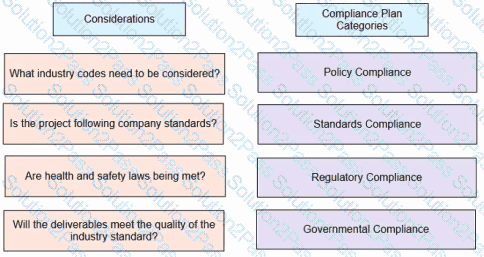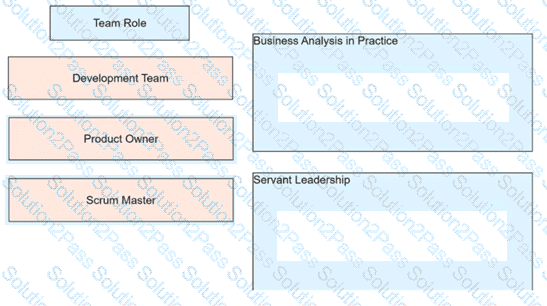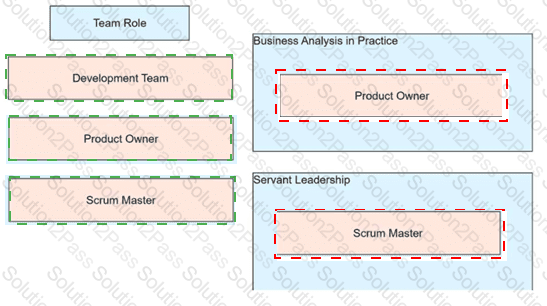PMP PMI Project Management Professional (2025 Version) Free Practice Exam Questions (2025 Updated)
Prepare effectively for your PMI PMP Project Management Professional (2025 Version) certification with our extensive collection of free, high-quality practice questions. Each question is designed to mirror the actual exam format and objectives, complete with comprehensive answers and detailed explanations. Our materials are regularly updated for 2025, ensuring you have the most current resources to build confidence and succeed on your first attempt.
While monitoring a project at a work site, the project manager notices that the site team’s work breaks have increased by a few minutes every week. How should the project
manager approach this?
A team is delivering features to a customer at every iteration. After completing each iteration, the customer is invited for a review. However, the customer is frequently not
available and the review is often delayed, which results in increased rework for the team.
What should the project manager do?
Eight highly qualified experts have been assembled to work for a 6-month period on an a specific aspect of an organization's product development process. How should the
project manager support this team to succeed?
A project manager is part of a global project team and is in charge of managing the scope defined by their country. There is a clear division regarding which pieces of the
scope should be treated by global and local teams. During the last sprints, the project manager has been receiving requests that the global team should handle.
What should the project manager do in this situation?
A key stakeholder is refusing to participate in a crucial project stage and disagrees with the project team's approach. This situation is affecting the project team's morale.
What should the project manager do?
A project manager is performing earned value management (EVM) for a cross-country pipeline project. The project manager has determined the ratio of earned value (EV)
to actual cost (AC) for the project and has found the calculated result to be 0.9024.
What does this value mean for the project?
At a project meeting, a business analyst requires input from a marketing consultant to continue working on a task. The business analyst has tried
to contact the consultant but has been told that the consultant does not have the time to discuss the project.
What should the project manager do to move the project forward?
A team needs to implement a mandatory compliance regulation in a product, which is required for its release. While nearing the product release, when completeness was
being verified, it was found that the compliance part was not implemented in the project.
What should the project manager do next?
An oil and gas project started without having acquired full funding for the project. The remaining funds were to be acquired during project
execution. The acquisition of the remaining funds was delayed several months, resulting in a suspension of work by all contractors.
What should the project manager have done to prevent this from happening?
During project implementation, one team finds out that a key project deliverable was not budgeted. What should the project manager do first?
A project manager is managing a project with team members who are working all over the globe. The project manager notices that each team
member's deliverables do not meet the requirements.
What should the project manager do first?
A project manager is leading a project in a heavily regulated industry. Match the considerations on the left with the correct compliance plan categories on the right.

An organization that embraced agile a couple of years ago is looking for a more efficient way to ensure that the increments produced in each sprint meet the end users’ quality requirements. What should the project lead recommend?
A project manager is working as a servant leader for a pilot project to adopt agile practices. After three sprints, the team demos the product to the
main stakeholders, but receives negative feedback about the product's features. The team feels that all the features met the acceptance criteria
defined by the product owner and does not understand what went wrong.
How should the project manager mitigate the product rejection?
A healthcare company is in the process of deploying an innovative healthcare solution globally. The project team has completed a limited release.
The stakeholders have raised concerns about global healthcare guidelines and risks.
What should the project manager do next?
A project manager was replaced in the early phases of a new project. The new project manager discovers that the business team is not supporting the project. After
discussing these concerns with the team, it is determined that the project does not have the full support of senior management.
What should the new project manager do next?
An agile team is developing a new content management system. Some of the team members are struggling to deliver certain features since they have never worked on this type of solution.
What should the project manager do?
During the execution phase of a project, a new department has been created in the company. The manager of this department has requested to
be involved in the regular project communications and reporting cycles.
What should the project manager do?
A senior project manager is working for a company that is not yet making a profit. However, the company has many innovative projects in development. Most of the project
time lines have slipped, and the staff is overwhelmed .
What should the project manager do to help the company meet their financial objectives?
A project manager is part of an organization that is assessing the use of agile delivery approaches. A new project management office (PMO) manager who had a bad experience with a Scrum approach recommended that the project board replace Scrum with a predictive approach.
What should the project manager do?
Project acceptance criteria include on-site training for the new users of a system. Due to unforeseen circumstances, all team members have to work remotely for an indefinite period of time.
What should the project manager do?
A project is near completion but it is behind schedule. The contingency budget has already being used, although the remaining budget should be
enough to complete the project. The only subject matter expert (SME) assigned to the project has been asked by their manager to solve a
problem in the operations department.
What should the project manager do?
A project manager works for an organization that intends to begin using agile delivery, but there is a lack of support from some business units. The project manager needs to address the lack of trust in agile.
What should the project manager recommend?
A project manager is managing a large project. During a review meeting, the project manager discovers that one of the team members who use to be a high performer was not able to complete their work on time.
What should the project manager do?
In the initiating phase of a project, the project manager and team members are prioritizing the product backlog along with the product owner. What should the project
manager do next?
A project is on its fourth iteration out of six. During iteration planning, a team member informs the project manager that their computer is not working.
What should the project manager do next?
A project manager is working on a software development project for an oil and gas client using an agile approach. The project manager is having difficulty preparing the schedule because the project has various unknowns.
Which scheduling method should the project manager use to develop the schedule?
A customer has provided excellent feedback on the project. However, a key project resource is leaving the company.
Which measure should mitigate the impact of this key resource's departure?
A project manager is implementing a project similar to a previous one that required strict adherence to occupational health and safety (OHS). Both projects are for the same client whose business environment is highly regulated. However, this time the client does not appear to be concerned about OHS requirements.
What should the project manager do first?
A company's key product is evolving and requires the use of a new technology. No one on the team is familiar with this technology; however, experienced developers on the team volunteered to study the concepts and application and believe they will be able to take full responsibility for the new technology.
What should the project manager do?
A production team will soon begin their first agile project. No one in the team or management has agile knowledge. The training manager can only fund three enrollments.
Match the team role on the left to the correct training course on the right. (Use all three of the team roles.)

An organization is transitioning to agile delivery, and a new team has been assembled. A project is not going well because the variation of the team velocity is very high and every sprint delivers less than committed. A new project lead with a strong technical background has been assigned to the project.
What should the project lead do?
A team is preparing the closing phase and building a plan for the next phase. One of the project sponsors is complaining that the last phase had some quality deliverable issues. However, the quality acceptance document was signed.
What should the project manager do?
A project manager has received feedback from stakeholders regarding poor communication about project progress. Weekly status reports were provided to the project management office (PMO), and the standard communications management plan was followed.
What should the project manager do?
An agile team has released the second version of its product, but the feedback is that the software has many bugs that compromise the user experience. What should the
project manager do?
A business transformation project has a four-phase delivery plan. The project team has successfully delivered one phase of the project.
To further enhance team performance and empower team members, which two actions should the project manager take? (Choose two)
A project is halfway through its execution phase. The quality specifications for the project deliverables are formally accepted. However, a key stakeholder is dissatisfied, stating that the deliverables do not meet the quality specifications.
What should the project manager do in this situation?
After sending an on-site meeting invitation to seven people for the kick-off meeting of a project, a key stakeholder declines because they will be at another location for the rest of the month.
What should the project manager do?
At the end of a project, the project manager was asked to provide a performance rating of the project team members. What should the project manager mainly make reference to?
A project for a financial organization is in the proposal phase for the selection of a software tool. There have been conflicting opinions on the software that was ranked in the selection. After analyzing the issue, the project manager realizes that two out of the eight teams have concerns about the tool's scalability to support their business needs.
How should the project manager resolve this conflict and reach a consensus?
A project is on its fifth iteration out of six. One member of the team has left the company unexpectedly.
What should the project manager do next?
A project manager analyzes the cumulative flow chart and identifies a bottleneck in the testing activities from a self-organizing team. After discussing it with the team, a gap related to testing skills is identified.
What should the project manager do to address the issue?
A project manager is tasked with developing a coaching model to support and recognize team members' growth.
What should the project manager consider when defining their coaching strategy?
A project team has expressed concern that certain remote team members are not able to collaborate with the larger project team due to their work schedule. The project
manager is confused since the entire team is located in the same time zone and believes there are other factors at play.
What should the project manager do next?
During iteration planning, team A identifies that an important deliverable is dependent upon a deliverable from team B. What should the project manager do?
Due to contractual issues, a key team member cannot travel to the project location for a design review meeting.
What should the project manager do?
The project manager of a globally dispersed team evaluates the organization's current virtual engagement tools and strategies. A couple of the remote team members are not participating effectively in virtual meetings.
Which action should the project manager take to improve remote engagement?
A laboratory is launching a new product, defined to be executed in eight iterations with a fixed release date. At the beginning of the second
iteration, the project manager realizes that a significant regulatory feature is missing in the project backlog.
What should the project manager do?
A project manager just completed a successful deployment and is preparing to transition the project to an operational state before starting closeout actions. What should the project manager do to ensure that the project is ready to move to an operational state?
A project manager who recently joined the company has been assigned to manage a software project for a major recurring customer. What should the project manager do to
enhance the budget estimations for the project?
A distributed project team has communication issues because of their collaboration tools. The team feels that efficiency could be improved by changing the collaboration platform.
What should the project manager do?
During iteration two of a project with two teams {A and B), the project manager is concerned that there are two critical activities from team A that must be started in iteration four. Additionally, these two activities are dependent on an activity from team B that has not yet been prioritized.
What should the project manager do?
A project manager is leading a long-term project, executed in stages, to set up a complex communications network in many rural areas. The project is being executed in stages.
What should the project manager do to ensure that monetized business value is generated as planned?
During a project, the project manager finds an opportunity to reduce the project cost by completing a deliverable ahead of schedule with a minimal
impact on project resources. However, the client has only been focused on the next milestone.
How should the project manager approach this situation?
A project team is implementing a hosted system for a third party. Just before going live, the customer asks the project team to include additional functionality. The project
team identified risks to the delivery date and informed the project manager that some of the requested functions are in conflict with the agreed scope.
What should the project manager do?
A startup company has just appointed a CEO that has no prior project experience. The CEO wants to execute projects with their own resources
and has appointed a project manager.
What should the project manager recommend that the CEO do first?
A customer initiated a minor scope change and expects this to be completed without delays or additional costs. The project manager believes that they have adequate
authorization to make the decision themselves but is not quite sure.
What should the project manager do next?
A project team member is sick and will not be able to return to the project for a few weeks. During the daily meeting, the team shares their concerns as the sick team member was the only one skilled in the component they were developing.
What should the project manager have done to prevent this?
There are two interdependent projects: the first project is in execution, and the second one is about to be deployed. The first project has been delayed, which is now affecting the second project due to the sharing of resources.
What should the project manager do in this situation?
A project manager is leading a hybrid project funded by a time and materials (T&M) agreement. The project was completed, and the client
accepted the delivery of the product. One week later, the client asked the project manager to fix two defects they found in the product. The project
manager responded with an estimate of time and money and asked the client to confirm this. The client disagreed and insisted that the work
should be done for free because it is a defect in the product.
What should the project manager have done to prevent this?


